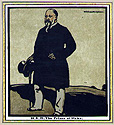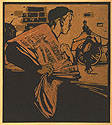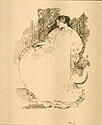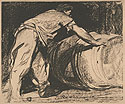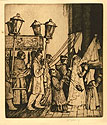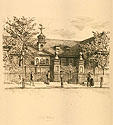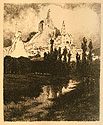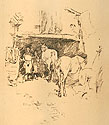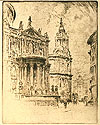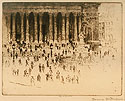Introduction
On the occasion of Georgetown’s students returning for the Fall semester, and the University’s participation in September’s interdisciplinary conference entitled The Arts of the British 1890s, a joint project of the Smithsonian’s Freer Gallery of Art, Georgetown’s Department of English, and the National Gallery of Art, in association with The William Morris Society and The Eighteen Nineties Society, the Fairchild Memorial Gallery is pleased to present this exhibition entitled British Printmakers of the 1890s.
The following comments with checklists for each section are offered to enhance the viewer’s understanding and enjoyment of the exhibition. All of the works have been selected from Georgetown’s fine print holdings in the Special Collections Division of the University Library.
A Selection of Their Works
Section I begins with two of Sir William Nicholson’s color lithographs from his popular editions published in 1898 by Heinemann: “H.R.H. The Prince of Wales” from the Twelve Portraits series, and “Paper-Boy” from the London Types.
The next two deal with farmhands going about their chores, one by the London-born Henry La Thangue, and the other by the French emigré Alphonse Legros. On Whistler’s advice, Legros migrated to London in 1863 where he accepted an offer to teach printmaking at the South Kensington School of Art. By 1880, he had become a British citizen, and had moved on to teach at the Slade. When he died in 1911 with an oeuvre of over 700 prints to his credit, he was claimed by both the French and the British as their own.
Moving on to William Rothenstein’s prints, we come to his splendid 1897 lithograph portraying his two fellow printmakers, “Charles Ricketts & Charles H. Shannon,” which appears on our front cover. Note Rothenstein’s delicacy of line as well as that of Shannon’s in his lithograph, “The Letter,” which follows. Contrast these with Frank Brangwyn’s heavier lines in “A Cooper at Work” exhibited close by.
With the next pair we come to William Strang’s classic portrait of “Cunninghame Graham” (1852 – 1936). An ardent socialist and follower of William Morris, he is reported to have been the first member of the House of Commons to be suspended for using the word “damn” in that august chamber. Below it is Colonel Robert Goff’s lithograph, “Brighton Front,” dated 1895. Goff, an accomplished amateur printmaker, retired from the Coldstream Guards in 1878 to devote himself full time to his art.
The following pair includes Sir Frank Short’s 1896 mezzotint, “Lucerne,” after a drawing by Turner. Short, who revived the mezzotint and aquatint techniques of printmaking in England, went on to earn national recognition as head of the engraving school of the Royal College of Art where he served from 1891 until his retirement in 1924.
The section ends with Sidney Hall’s lithograph, “The Disputed Passage.” Here is an Oxford don in cap and gown expounding on some now forgotten controversy, or was he from Cambridge? Might it have been one of those Whistlerian disputes which raged in the press and in the law courts of the day, as when Sickert called Pennell’s transfer lithographs “reproductions” in the Saturday Review in 1896? Pennell, backed by Whistler, sued for libel and won. Or might it have been some passage in Whistler’s own book, The Gentle Art of Making Enemies? We will probably never know.
More Examples
Section II begins with Simeon Solomon’s portrait of a woman, entitled “A Venetian Study,” a chalk drawing in sepia dated 1892. It is one of several Solomon drawings bequeathed to Georgetown by the late collector and patron, Mrs. Edith Mayfield.
In the following threesome of etchings we find William Strang’s “Procession at Furnes” of 1898, Sir George Clausen’s undated “Early Morning—September,” and Edward Millington Synge’s exquisite little French landscape, “Pont Aven,” completed in 1900.
In the next threesome we have John Arnesby-Brown’s “Autumn Morning” with its grazing horses, William B. Hole’s ships in “Leigh Docks,” and William Strang’s “An Upland Farm” dated 1891 in the plate. This proof is a later pull of Strang’s etching by his son, David, an accomplished etcher in his own right, and printer for a number of important etchers of his day, including John Taylor Arms.
Now comes D. Y. Cameron’s large etching in sepia, “The Old Revenge,” published in 1890. This portrait of an old wooden hulled British battleship bears striking resemblance to Seymour Haden’s masterful “Breaking Up of the Agamemnon” completed some twenty years earlier.
A pair of interesting London cityscapes comes next. The first is an etching by William Wyllie, “London and Tower Bridges,” seemingly done from the air. It is followed by Mortimer Menpes’ etching with drypoint, “St. Martin’s in the Field.” Note the fine tonal qualities Menpes captured with his drypoint needle in adding the rich blacks and deep shadings.
Moving on we come to three lithographs by Thomas R. Way, the skilled lithographer and sometime friend of Whistler’s who encouraged him to take up lithography and who printed most of his stones. Here we find Way’s “Graycoat School” of 1897 and his 1898 untitled color lithograph of a group of children and a few adults lingering in a London mews. These are followed by his tour-de-force masterpiece of 1898, “A Hawthorne Pot.”
The section ends with Lord Frederic Leighton’s portrait of an unidentified young woman, a lithograph in sepia signed in the stone. Might it be that of Dorothy Dene, an aspiring actress and model he used in a number of his later works? The Yellow Book carried two of his drawings in its first number in 1894. Leighton was raised to the peerage in 1896, the only British artist to receive that honor.
THE • STUDIO Prints
A survey of British printmakers in the 1890s would be incomplete without recognition of the influence and contributions of The Studio, a monthly illustrated magazine of fine and applied art founded in London in 1893 by Charles Holmes. In its pages it encouraged the use of the fine arts where possible in both architectural and commercial applications, including advertising. And early on it gave coverage to the work of Aubrey Beardsley, William Morris, and the Aesthetic Movement.
More importantly, The Studio’s editors solicited and commissioned prints for publication in its pages by leading as well as lesser known printmakers of the 1890s and beyond, both British and continental. No less than five Whistlers appeared in its pages by 1897, each bearing The Studio’s distinctive blind stamp.
Section III opens with a copy of The Studio’s distinctive wrapper showing two practitioners of the applied and fine arts standing hand in hand under the branches of a stylized tree, each holding the symbolic implements of their creative professions. Mounted under this is an 1897 lithograph, “Le Puy,” by Joseph Pennell who was then living and creating prints in London. The Studio published a total of seven of his prints in its pages by 1900.
Following these is a selection of twelve more prints typical of those found in the pages of The Studio including two color lithographs by important French printmakers of the day. The first is “La Sevillana” by Alexandre Lunois, published in 1897. The other is “L’Imploration” by Henri Bellery-Desfontaines, published in 1896.
The final two prints in this section are by British artists we have already met in Section I: here is Henry La Thangue’s “Peasant Girl” published in 1895, and Colonel Goff’s “Sea Scape”' of 1896.
Plus 3 American Expatriates
Section IV brings this exhibition to a close with seven prints by three important American expatriate printmakers living in London during much of the 1890s—James McNeill Whistler, Joseph Pennell, and J. McLure Hamilton.
Whistler is represented with three prints. The first is his 1895 lithograph, “The Smith’s Yard,” which The Studio published in 1897. (The Studio had already published his “Gants de Suade” and his “Long Gallery” in 1894, and his “La Robe Rouge” and “Savoy Pigeons” in 1896.)
His second and third prints are a pair of portraits, “Fire Light: Joseph Pennell,” and “Firelight (Mrs. Pennell),” both drawn in 1896. Originally printed by Thomas Way, the Pennells later had them reprinted and bound as frontispieces into their co-authored book, The Whistler Journal, published in 1921. In a special limited edition of that book they also boldly autographed them. Here is Georgetown’s copy opened to those two autographed prints.
Pennell is represented by three of his London etchings, each dealing with St. Paul’s, and all thought to have been drawn by 1900. The first, “South Portico, St. Pauls,” is a rare etching on antique ledger paper, and is not listed in the Wuerth catalog of Pennell’s etched work.
His second etching is “St. Paul’s Pavement.” Note Pennell’s masterful treatment of the architecture of the building, especially its columns and their capitals, and note his skillful renderings of the comings and goings of the human throng in the foreground.
In his third print, “West Door, St. Paul’s,” we find Pennell at his best in combining the drypoint and etching processes to capture on his copper plate the delicate qualities of light and shadow as they play out before him.
J. McLure Hamilton, our third American expatriate, is represented here by his color lithograph of a gentleman totally absorbed in the fine art of reading, “The Rt. Hon. W. E. Gladstone.” Printed by Way, it was published by Joseph Pennell in 1898 in his book, Lithography and Lithographers. And with it, this exhibition of fin de siècle British Printmakers of the 1890s comes to an end.
Joseph A. Haller, S.J.
8/15/99
Portrait of W.P. Nicholson
Pryde, James Ferrier, 1869-1941
1898
Color lithograph
Nicholson was his brother-in-law.
Firelight: Joseph Pennell
Whistler, James McNeill, 1834-1903
1896
Lithograph
printed by Way, as later reprinted for frontispiece in The Whistler Journal, published by the Pennells in 1921, signed in ink by Joseph Pennell
Firelight: Mrs. Pennell
Whistler, James McNeill, 1834-1903
1896
Lithograph
printed by Way, as later reprinted for frontispiece in The Whistler Journal, published by the Pennells in 1921, signed in ink by Mrs. Pennell

